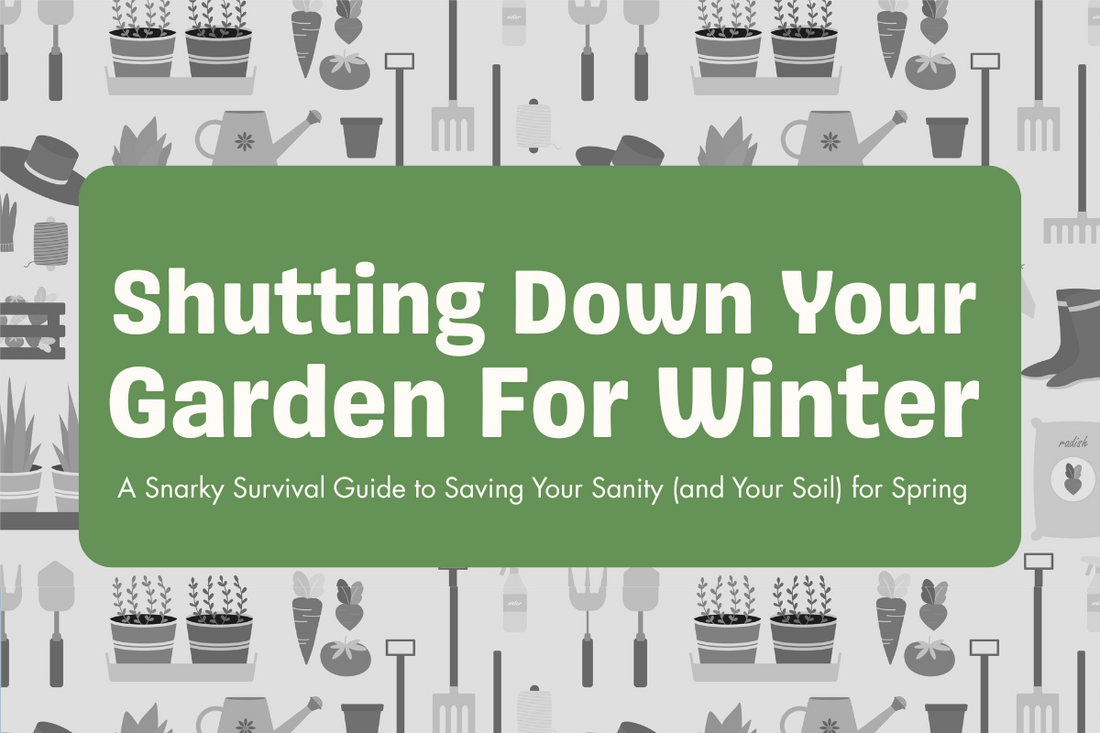Ah, winter—the time when you can finally stop pretending you're going to water your plants regularly and start cozying up inside with a hot drink - and a craft project. But before you fully commit to hibernation mode, you need to shut down your garden properly. You know, so you don’t emerge in spring to a wasteland of dead plants and weeds. Don’t worry; shutting down your garden isn’t rocket science, and if you follow these steps, you can get back to knitting your next blanket and Netflix binging in no time.

Why Bother Winterizing Your Garden?
Let’s be real—if you don’t do this, you'll probably regret it. Winterizing your garden is like paying off a credit card: boring but necessary.
Here’s why you should care:
- Protect your plants: Because you're not into throwing money away on replacements.
- Keep diseases and pests at bay: So next spring’s garden party isn’t also a bug buffet.
- Start spring strong: Sure, future you could deal with the mess, but why not be a little responsible?
If those reasons don’t motivate you, maybe the thought of fewer spring headaches will.

Step 1: Clean Up the Mess You Made
Look, it’s time to deal with the aftermath of your summer gardening ambitions. All those dead plants? Yeah, they need to go.
- Yank out the corpses: All those once-beautiful annuals? They’re done. Rip them out by the roots and say goodbye.
- Grab the last veggies: If you’ve still got cool-weather crops hanging on, get them before the frost turns them into sad, mushy disasters, and preserve them. (Also grab this 'Canning is my jam' t-shirt to wear while you're doing so)
- Give your perennials a haircut: Chop back anything that needs chopping—just don’t go too crazy. You want them to survive, after all.
Getting rid of this year’s debris will make spring way less annoying. You’ll thank yourself later, even if you’re grumbling now.

Step 2: Soil TLC (Because It’s Not Going to Fix Itself)
Your soil worked hard all season. Show it some love, or next year’s plants will stage a revolt.
- Weed out the freeloaders: Pull out the weeds now or deal with a forest of them later. No one wants to spend the first warm day of spring knee-deep in dandelions.
- Dump some compost: If you don’t have a compost pile, just pretend you’re enriching the soil with the ghosts of plants past. Compost or organic mulch will give back some nutrients and keep the soil from becoming a brick. For the easiest (laziest) method - try the cut and drop method of composting where you compost directly in your beds.
- Soil test, anyone?: Yeah, this sounds nerdy, but knowing your soil's pH can save you from a lot of future problems. Just do it now, so you're not playing guessing games later.
A little effort here saves you from dealing with lifeless dirt next spring. No one has time for that.

Step 3: Mulch It or Lose It
Winter can be brutal, so unless you want to roll the dice on which plants survive, it’s time to cover up.
- Mulch your perennials: Blanket them in a thick layer of organic mulch like you’re tucking them in for a long winter nap. Trust me, they’ll thank you.
- Wrap up those precious plants: For the fussy ones that can’t handle a little frost, you’ll need to wrap them up like burritos in burlap or plant covers.
- Dig up delicate bulbs: Some bulbs aren’t tough enough to survive winter, so dig them up and stash them indoors where they can ride out the cold in luxury. (Speaking delicate, why don't you gear up for your winter hibernation with a sweatshirt that reflects your gardening prowess, like our cozy 'World's Okay-est Gardener' sweatshirt)
You’re basically playing plant babysitter here, but it’s worth it if you want them to make a comeback next year.
Step 4: Deal With Your Tools and Beds (Like a Grown-Up)
If you think you can just throw your tools in the shed and forget about them, think again. Rust and frozen hoses are not your friends.
- Cover your garden beds: Whether it’s mulch, a tarp, or whatever you’ve got lying around, cover the beds so the weeds don’t take over. Do you really want to fight with them in spring?
- Clean and store your tools: I know, you’d rather do anything else, but unless you want to buy new tools next year, clean, sharpen, and store them. Future you will be thrilled.
- Drain your hoses: Water left in hoses will freeze, and then you'll have to replace them. It’s a simple task, but skipping it could cost you.
Once you’ve got this stuff handled, you can officially stop caring about your garden for a few months. Hallelujah.
Step 5: Pretend You’re Planning for Next Season
Now that your garden is on pause, use this time to plan ahead—if you're feeling particularly motivated. Spoiler: you probably won’t.
- Take some notes: What worked? What didn’t? Did that fancy heirloom tomato live up to the hype? Jot it down before you forget. It’ll help you avoid making the same mistakes next year. And sure, you could buy a garden journal, but maybe you're also looking for a craft to do while you're binging those fall favorites. Check out this guide for a DIY Garden Journal and Planner, at Gingham Gardens, where you can also find free printables for said journal.
- Order seeds early: If you want the best varieties, order them now. If you wait until spring, all the cool gardeners will have already snagged the good stuff.
- Dream up a new garden layout: Sure, your current setup works, but why not sketch out your ideal garden while you’ve got time to kill?
Winter is the perfect time to pretend you’ll be a better gardener next year—whether or not that actually happens is up to you.
Final Thoughts (or What’s Left of Them)
Winterizing your garden is like flossing: not particularly fun, but necessary if you don’t want a bigger problem down the road. Knock out these tasks, and you’ll be ready to binge-watch your way through winter without worrying about what’s going on in the backyard. Come spring, you’ll be that smug gardener who’s already prepared while everyone else is scrambling.
Happy hibernating, you overachiever!



